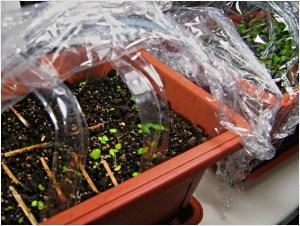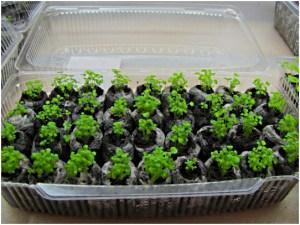How to grow strawberry seedlings from seeds on your own?
 Many do not risk growing new fruitful strawberry varieties on their own, thinking that they cannot do it. There is too much talk that this is a very laborious and risky work - you can spend a lot of time and effort, and as a result, nothing will come of it. So you have to be content with seedlings that they sell on the market or subscribe ready-made seedlings from dubious sites, which do not always reach the buyer in integrity.
Many do not risk growing new fruitful strawberry varieties on their own, thinking that they cannot do it. There is too much talk that this is a very laborious and risky work - you can spend a lot of time and effort, and as a result, nothing will come of it. So you have to be content with seedlings that they sell on the market or subscribe ready-made seedlings from dubious sites, which do not always reach the buyer in integrity.
How to grow strawberry seedlings yourself from seeds
Important! When choosing seeds, it is necessary to take into account the quality of the seeds, their regional affiliation, as well as the composition of the soil, where both strawberry seedlings and an adult plant will be grown. Seeds should be purchased only in specialized stores or retail outlets.
The quality of seedlings and the yield of berries depends on how correctly the seeds and soil will be prepared. There is nothing difficult, it is important to adhere to some rules.
Seed preparation for sowing
The time of planting a culture for seedlings of strawberries from seeds depends on the possibility highlight plants... The length of daylight hours should be at least 15 hours. If there is artificial lighting with fluorescent lamps, then strawberries are sown from January. If it is difficult or impossible to create lighting conditions, then in March.
After making sure of the quality of the seeds, they are sown in the prepared soil. To determine their germination, you need to soak in melt or rain water, changing it 1-2 times a day. Lay them on cotton pads, toilet paper or paper napkins. Cover with transparent polyethylene and put in a bright place with a temperature of about 20-23 C. After the seeds are nailed, they are planted in a prepared container using a toothpick or a sharpened match.
The stratification method allows you to get faster and healthier seedlings, and, accordingly, a higher strawberry yield.
Preparing land for growing strawberry seedlings
Prepare the required proportions of a mixture of soil. There are several options. Coarse-grained sand, peat with PH above 6, vermicompost. Mix everything in proportions: 1: 3: 1. Or sand, peat, top layer of the earth (sod) - 1: 1: 2.

- The soil is steamed in a thin layer over a boiling pan for 30-40 minutes, then placed in a sterilized box;
- Fry in a gas or electric oven at a temperature of about 100 degrees for 20-30 minutes;
- Using an old baking sheet or skillet, stir-fry the soil mixture over an open fire. Most often this is done on the street, having built a "stove" of several bricks.
Do not be afraid that all nutrients will die. At first, simple watering will be enough for the sprouts. And only after the bush gets a little stronger, they carry out all the necessary dressing.
How to sow strawberries correctly
They put the earth in a clean box, after cooling it down and tamping it slightly so that the seeds cannot sink deeply. Moisten the soil with clean water at room temperature from a spray bottle. Sow the seeds one at a time.Also use separate potsprepared cups, peat tablets... Or they grow cassette seedlings of strawberries, planting each individual seed in a separate container or cassette.
 Thin grooves are made with a match or a toothpick and with their help, having wet the tip, gently stick one seed at a time, laying them 2-3 cm apart. It is not necessary to sprinkle it with earth, there is a danger that the seedlings will not be able to break through the soil. To create a favorable microclimate for seedlings, cover the box with foil. They are placed in a dark place at a temperature of 18 C. It is worth watering as needed, avoiding waterlogging and drying out of the upper crust of the soil. Excess moisture will lead to fungal diseases and the appearance of a black leg, which means the death of the plant.
Thin grooves are made with a match or a toothpick and with their help, having wet the tip, gently stick one seed at a time, laying them 2-3 cm apart. It is not necessary to sprinkle it with earth, there is a danger that the seedlings will not be able to break through the soil. To create a favorable microclimate for seedlings, cover the box with foil. They are placed in a dark place at a temperature of 18 C. It is worth watering as needed, avoiding waterlogging and drying out of the upper crust of the soil. Excess moisture will lead to fungal diseases and the appearance of a black leg, which means the death of the plant.
The sprayed liquid should be very fine, without strong pressure, so as not to wash off the laid seeds and subsequently damage the young seedlings. Some gardeners use an ordinary medical syringe for watering, squeezing out literally one or two drops of water per seed.
After the emergence of shoots, and they are usually very thin and delicate, water them as well - one drop from a syringe, in no case falling on the shoots. Otherwise, they will simply fall and cannot rise. The utmost accuracy and patience are important here. Seedlings of remontant strawberries are obtained in the same way as for ordinary garden or "disposable". Moreover, its seeds are somewhat larger, which in turn facilitates the process of planting a crop.
Sowing strawberries in the snow
This method replaces stratification by simultaneously placing the seeds as the snow melts in their natural conditions. They do not deepen, but are located on the surface. In addition, the soil is moderately moistened with non-main water, and thawed, which will only have a positive effect on the germination and growing of strawberry seedlings from seeds.
Snow is laid on the prepared soil, with a layer of no more than 1.5-2 cm. Seeds are carefully laid out on top of it. Once the snow has melted, the seeds will naturally settle into the soil. They should no longer be corrected. Further, they are also covered with a film and, as necessary, ventilated and moistened.
We plant strawberry seedlings in the ground
After the appearance of 4-6 leaves and reaching the trunk, 5 cm in size, the strawberry seedlings from the seeds are planted in the ground.
But before that, they harden it, first taking it out into the street and setting the boxes in the shade. Do not leave unseasoned seedlings in the sun. Unadapted leaves will easily get burned, and the plant will have a hard time transplanting. This will definitely affect the timing and volume of the harvest.
 To develop a more powerful root system when transplanting, you need to pinch the main root. Then the lateral ones will begin to develop, which will increase the flow of moisture and minerals to the plant. It is not worth adding top dressing during transplantation. This will only reduce the survival time of strawberry seedlings from seeds. Top dressing should be carried out after the plants "take root". Most often this happens after a couple of weeks.
To develop a more powerful root system when transplanting, you need to pinch the main root. Then the lateral ones will begin to develop, which will increase the flow of moisture and minerals to the plant. It is not worth adding top dressing during transplantation. This will only reduce the survival time of strawberry seedlings from seeds. Top dressing should be carried out after the plants "take root". Most often this happens after a couple of weeks.
During transplanting, the seedlings should be watered abundantly, and covered with mulch on top to prevent the topsoil from drying out. In the next 2 weeks, plant care will consist of timely watering and gentle loosening of the soil. Then you can add ash and humus to the beds.
Council. Do not spray water during flowering. Watering is carried out only under the plants, without eroding the roots.
If, after flowering, cut off the smallest and greenest ovaries, then the rest of the berries will form larger and tastier. Accordingly, the presentation will be much more attractive.